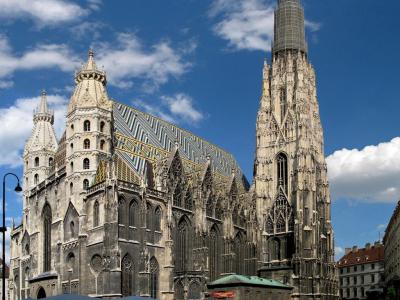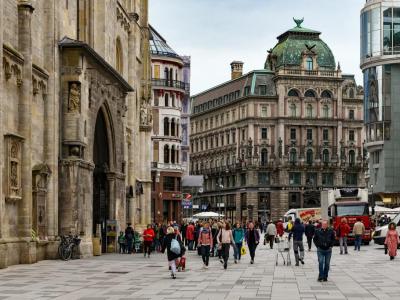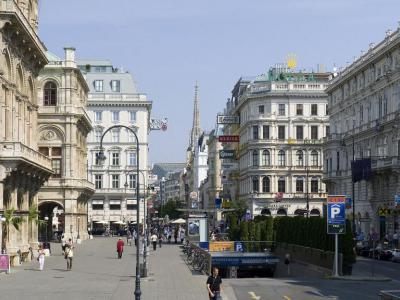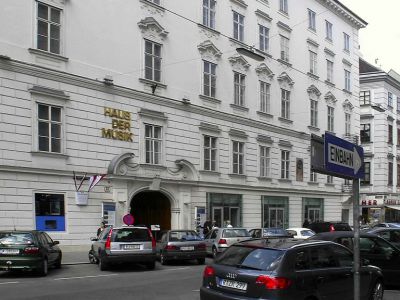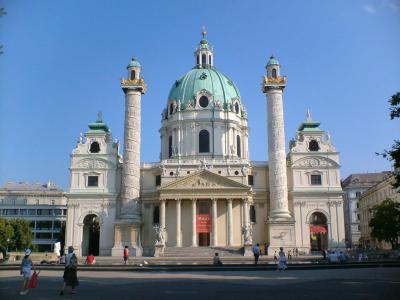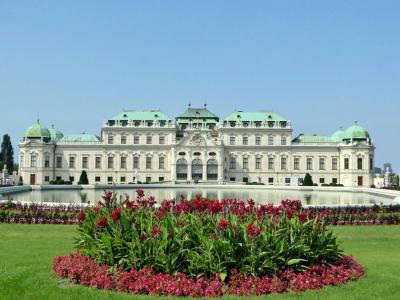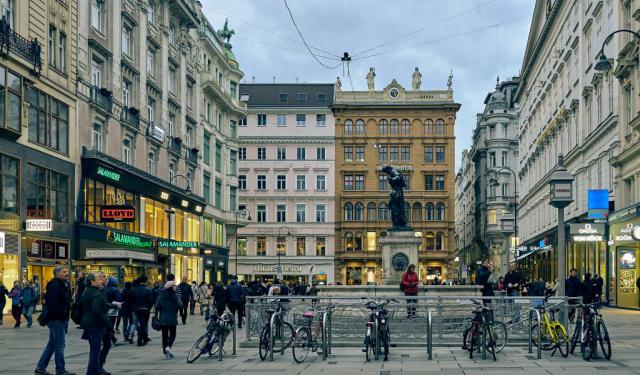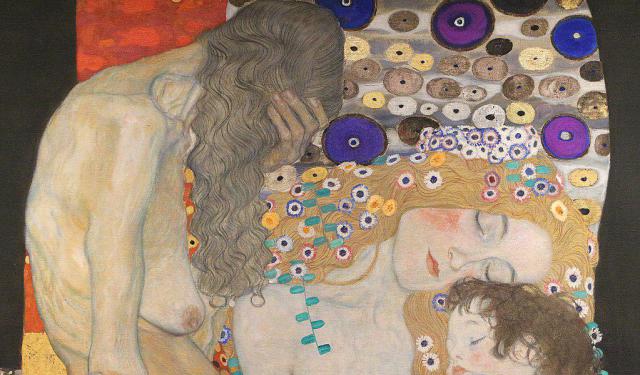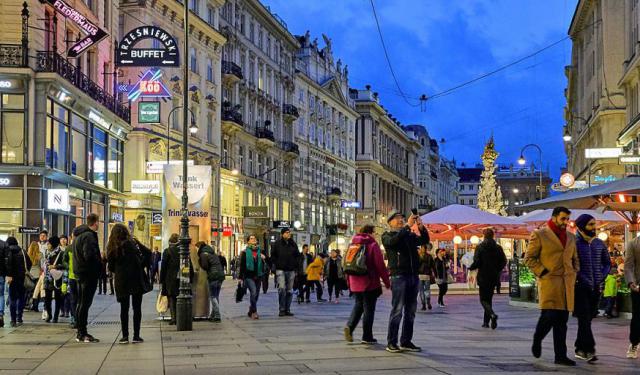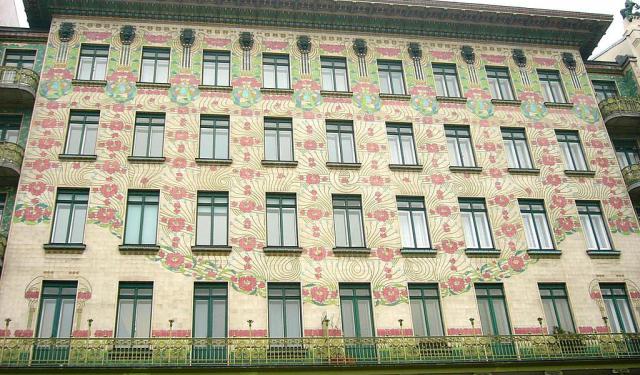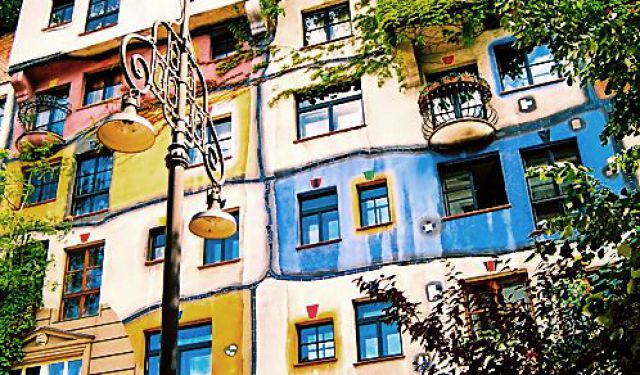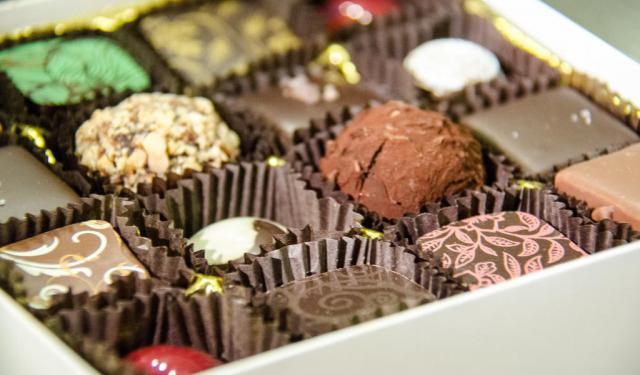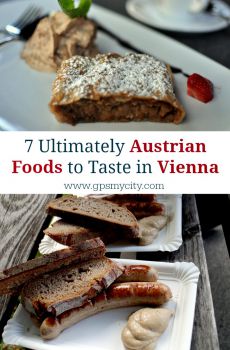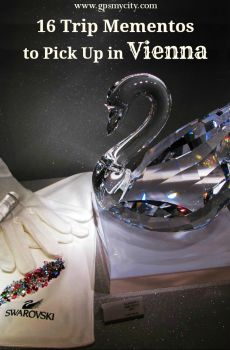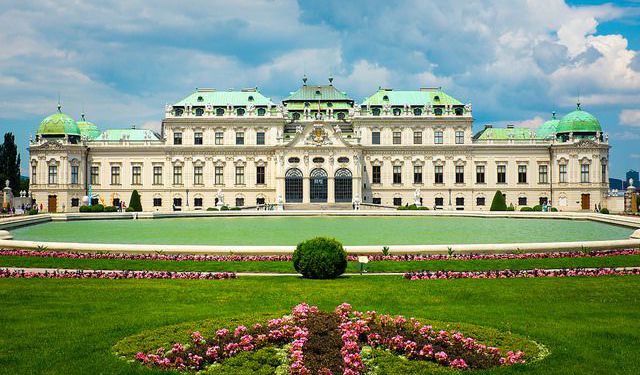
Vienna Introduction Walking Tour II (Self Guided), Vienna
Vienna, the former capital of the once mighty Austro-Hungarian Empire, is the second largest city in the German-speaking world after Berlin. Steeped in history, today's Vienna is still much revered for its cultural grandeur. The abundance of it, manifested in imperial palaces, diverse museums, and historic churches, beckons annually over 6 million guests from around the world.
One of the most iconic landmarks in Vienna is Saint Stephen's Cathedral (Stephansdom), a stunning Gothic masterpiece from the 12th century and a true testament to Vienna's enduring heritage. Nearby, Saint Stephen's Square (Stephansplatz) is a bustling hub where locals and visitors alike converge to soak in the city's vibrant atmosphere.
For those in search of a shopping experience like no other, Carinthian Street (Karntner Straße) is a must-visit destination. This historic thoroughfare is lined with an array of shops, boutiques, and cafes, making it the perfect place to indulge in some retail therapy or savor a cup of Vienna's famous coffee.
Music enthusiasts will find their haven at the House of Music (Haus der Musik), which offers an immersive journey through the world of sound and classical compositions. Vienna's deep-rooted connection to music is further exemplified by Saint Charles' Church (Karlskirche), a Baroque masterpiece known for its breathtaking frescoes and an extraordinary acoustic design that sets the stage for magnificent concerts.
And then there's the Belvedere Palace, a testament to Vienna's imperial history. This architectural marvel is home to a stunning art collection, including the world-renowned works of Gustav Klimt, particularly "The Kiss." The palace and its extensive gardens showcase the opulence of the Habsburg dynasty.
Vienna is a city that seamlessly blends tradition and modernity, offering a multitude of experiences for every type of traveler. On the second part of our self-guided introductory walk, we're excited to introduce you further to this magnificent European gem. As you delve into the Viennese “art of living” (Lebenskunst), you will realize that despite changing rulers and times, Vienna has retained almost the same pace and much the same style as centuries ago.
One of the most iconic landmarks in Vienna is Saint Stephen's Cathedral (Stephansdom), a stunning Gothic masterpiece from the 12th century and a true testament to Vienna's enduring heritage. Nearby, Saint Stephen's Square (Stephansplatz) is a bustling hub where locals and visitors alike converge to soak in the city's vibrant atmosphere.
For those in search of a shopping experience like no other, Carinthian Street (Karntner Straße) is a must-visit destination. This historic thoroughfare is lined with an array of shops, boutiques, and cafes, making it the perfect place to indulge in some retail therapy or savor a cup of Vienna's famous coffee.
Music enthusiasts will find their haven at the House of Music (Haus der Musik), which offers an immersive journey through the world of sound and classical compositions. Vienna's deep-rooted connection to music is further exemplified by Saint Charles' Church (Karlskirche), a Baroque masterpiece known for its breathtaking frescoes and an extraordinary acoustic design that sets the stage for magnificent concerts.
And then there's the Belvedere Palace, a testament to Vienna's imperial history. This architectural marvel is home to a stunning art collection, including the world-renowned works of Gustav Klimt, particularly "The Kiss." The palace and its extensive gardens showcase the opulence of the Habsburg dynasty.
Vienna is a city that seamlessly blends tradition and modernity, offering a multitude of experiences for every type of traveler. On the second part of our self-guided introductory walk, we're excited to introduce you further to this magnificent European gem. As you delve into the Viennese “art of living” (Lebenskunst), you will realize that despite changing rulers and times, Vienna has retained almost the same pace and much the same style as centuries ago.
How it works: Download the app "GPSmyCity: Walks in 1K+ Cities" from Apple App Store or Google Play Store to your mobile phone or tablet. The app turns your mobile device into a personal tour guide and its built-in GPS navigation functions guide you from one tour stop to next. The app works offline, so no data plan is needed when traveling abroad.
Vienna Introduction Walking Tour II Map
Guide Name: Vienna Introduction Walking Tour II
Guide Location: Austria » Vienna (See other walking tours in Vienna)
Guide Type: Self-guided Walking Tour (Sightseeing)
# of Attractions: 6
Tour Duration: 1 Hour(s)
Travel Distance: 2.7 Km or 1.7 Miles
Author: alexei
Sight(s) Featured in This Guide:
Guide Location: Austria » Vienna (See other walking tours in Vienna)
Guide Type: Self-guided Walking Tour (Sightseeing)
# of Attractions: 6
Tour Duration: 1 Hour(s)
Travel Distance: 2.7 Km or 1.7 Miles
Author: alexei
Sight(s) Featured in This Guide:
- Stephansdom (St. Stephen's Cathedral)
- Stephansplatz (St. Stephen's Square)
- Karntner Straße (Carinthian Street)
- Haus der Musik (House of Music)
- Karlskirche (St. Charles' Church)
- Belvedere Palace
1) Stephansdom (St. Stephen's Cathedral) (must see)
With its intricately patterned tiled roof, the imposing Gothic cathedral of Saint Stephen's (Stephansdom) is a prime landmark inside Vienna's old city center, having stood watch over the place for nearly 700 years. Its distinctive south tower rises to an impressive 445 feet and previously has served as the main observation and command post for the city's walled defense, for which purpose it even contained an apartment for watchmen who, until 1955, manned the tower at night and rang the bells if a fire was spotted. There was to be a twin north tower, but for several reasons, it ended up being just half the size and of a different design.
The views from the Watch Room, at the top, are surely worth climbing the 343 steps, otherwise you can take a lift up to a viewing platform on the shorter tower, home to the massive Pummerin ("Boomer") Bell – the largest in Austria, originally cast from melted-down cannons abandoned by the Turks while fleeing Vienna in 1683.
High points of the interior are the gorgeous vaulting of the Albertine Chapel, the stone pulpit (a masterwork of late Gothic sculpture), canopies or baldachins over many of the side altars, and a most spectacular Renaissance work – Friedrich III's tomb. You also won't want to miss the 14th century catacombs and the treasury where some of the cathedral's most valuable objects are displayed. Some of them can only be seen on a guided tour, such as a red marble sepulcher sculpted in 1467-1513, the 16th-century pulpit, a Gothic winged altar from the 1440s, and the tomb of Prince Eugene of Savoy dated 1754.
Visit Saint Stephen's Cathedral and you'll be standing in the same church in which Joseph Haydn once sang as a choir boy until his voice broke, and where Johann Strauss married both of his wives, Henrietta Treffz and Angelika Dittrich. A memorial tablet gives a detailed account of Wolfgang Amadeus Mozart's relationship with the cathedral, including that of him being appointed an adjunct music director here shortly before his death. This was his parish church when he lived at the Figaro House and he was married here; two of his children were also baptized at Saint Stephen's, and his funeral was held in the Chapel of the Cross inside.
Why You Should Visit:
While incredible architecture is rather commonplace in Vienna, this majestic Roman-Gothic masterpiece is absolutely unmistakable and not to be missed.
Tip:
Be sure to make a loop around the structure as there are many interesting details still visible on the outside walls.
The views from the Watch Room, at the top, are surely worth climbing the 343 steps, otherwise you can take a lift up to a viewing platform on the shorter tower, home to the massive Pummerin ("Boomer") Bell – the largest in Austria, originally cast from melted-down cannons abandoned by the Turks while fleeing Vienna in 1683.
High points of the interior are the gorgeous vaulting of the Albertine Chapel, the stone pulpit (a masterwork of late Gothic sculpture), canopies or baldachins over many of the side altars, and a most spectacular Renaissance work – Friedrich III's tomb. You also won't want to miss the 14th century catacombs and the treasury where some of the cathedral's most valuable objects are displayed. Some of them can only be seen on a guided tour, such as a red marble sepulcher sculpted in 1467-1513, the 16th-century pulpit, a Gothic winged altar from the 1440s, and the tomb of Prince Eugene of Savoy dated 1754.
Visit Saint Stephen's Cathedral and you'll be standing in the same church in which Joseph Haydn once sang as a choir boy until his voice broke, and where Johann Strauss married both of his wives, Henrietta Treffz and Angelika Dittrich. A memorial tablet gives a detailed account of Wolfgang Amadeus Mozart's relationship with the cathedral, including that of him being appointed an adjunct music director here shortly before his death. This was his parish church when he lived at the Figaro House and he was married here; two of his children were also baptized at Saint Stephen's, and his funeral was held in the Chapel of the Cross inside.
Why You Should Visit:
While incredible architecture is rather commonplace in Vienna, this majestic Roman-Gothic masterpiece is absolutely unmistakable and not to be missed.
Tip:
Be sure to make a loop around the structure as there are many interesting details still visible on the outside walls.
2) Stephansplatz (St. Stephen's Square)
Stephansplatz stands as a central square in Vienna, situated at its geographical heart. This square takes its name from the Stephansdom, Vienna's primary cathedral and one of the world's tallest churches, which stands as its most prominent landmark. Before the 20th century, a line of houses separated Stephansplatz from Stock-im-Eisen-Platz. However, with the demolition of these structures, the name Stephansplatz came to encompass the broader area that includes both squares.
To the west and south, we find the upscale shopping streets known as der Graben, which translates to "the Ditch," and Kärntner Straße, with "Kärnten" being the German word for Carinthia. Opposite the Stephansdom lies the Haas-Haus, an architecturally striking modern building designed by Hans Hollein. Initially, public sentiment expressed skepticism about the juxtaposition of a medieval cathedral and a glass-and-steel structure. Nevertheless, it is now regarded as an exemplar of how old and contemporary architecture can coexist harmoniously.
Why You Should Visit:
While this might not be the best location for a gourmet meal, sitting in one of the local cafes does provide for world-class people watching in a prime historic location. With the Stephansdom dominating the scene, you can't go wrong.
Tip:
While in Stephansplatz, walk around the side of the Stephansdom to see a miniature thereof. It's quite fun to see it tiny!
To the west and south, we find the upscale shopping streets known as der Graben, which translates to "the Ditch," and Kärntner Straße, with "Kärnten" being the German word for Carinthia. Opposite the Stephansdom lies the Haas-Haus, an architecturally striking modern building designed by Hans Hollein. Initially, public sentiment expressed skepticism about the juxtaposition of a medieval cathedral and a glass-and-steel structure. Nevertheless, it is now regarded as an exemplar of how old and contemporary architecture can coexist harmoniously.
Why You Should Visit:
While this might not be the best location for a gourmet meal, sitting in one of the local cafes does provide for world-class people watching in a prime historic location. With the Stephansdom dominating the scene, you can't go wrong.
Tip:
While in Stephansplatz, walk around the side of the Stephansdom to see a miniature thereof. It's quite fun to see it tiny!
3) Karntner Straße (Carinthian Street)
Kärntner Straße (Carinthian Street) serves as Vienna's primary shopping hub and has a rich history dating back to Roman times. Originally named Strata Carinthianorum, with its earliest recorded mention dating back to 1257, this street used to connect the city center to the city wall. Although most of the historic buildings from that era were lost during World War II, a few have managed to survive.
Today, Kärntner Straße stretches from Stephansplatz to Karlsplatz and boasts a plethora of charming old buildings, traditional shops, and flagship stores of well-known international luxury brands. Some of these stores are tucked away in the adjacent side streets. Along the way, the street is adorned with historical treasures, including the Winter Palace of Prince Eugene and Neuermarkt. Amidst the modern retail outlets that surround it, the Maltese Church stands as a striking anachronism. Finally, at the end of Kärntner Straße, one encounters the majestic Wiener Staatsoper, also known as the Vienna State Opera House.
In 1974, Kärntner Straße was transformed into a fully pedestrianized area, much to the delight of both local residents and tourists who frequent the street for shopping, leisurely strolls, and overall enjoyment.
Why You Should Visit:
Great for shopping, people-watching, and admiring Vienna's baroque architecture.
Tip:
Can get pretty crowded, especially during peak tourist season.
Today, Kärntner Straße stretches from Stephansplatz to Karlsplatz and boasts a plethora of charming old buildings, traditional shops, and flagship stores of well-known international luxury brands. Some of these stores are tucked away in the adjacent side streets. Along the way, the street is adorned with historical treasures, including the Winter Palace of Prince Eugene and Neuermarkt. Amidst the modern retail outlets that surround it, the Maltese Church stands as a striking anachronism. Finally, at the end of Kärntner Straße, one encounters the majestic Wiener Staatsoper, also known as the Vienna State Opera House.
In 1974, Kärntner Straße was transformed into a fully pedestrianized area, much to the delight of both local residents and tourists who frequent the street for shopping, leisurely strolls, and overall enjoyment.
Why You Should Visit:
Great for shopping, people-watching, and admiring Vienna's baroque architecture.
Tip:
Can get pretty crowded, especially during peak tourist season.
4) Haus der Musik (House of Music)
Haus der Musik, also known as The House of Music, stands as a contemporary museum designed to offer visitors a hands-on experience with its exhibits on multiple levels. Spanning five floors, it is a unique museum entirely dedicated to the captivating realms of music and sound.
Covering an expansive 5,000 square meters, this facility has garnered numerous awards for its innovative approach to presenting its collections. Notable among these displays are various musical inventions that vividly showcase the diverse interpretations of what constitutes music. The range of experiences is truly astonishing. Here, you can take the reins of the Vienna Philharmonic, compose your own musical creations, witness your name inscribed in music by the hand of Mozart, and view the Vienna Philharmonic in action through videos of their New Year's and summer concerts.
An intriguing aspect of this venue is its historical location within the former Palace of Archduke Charles, which was once inhabited by Otto Nicolai during the mid-19th century. Nicolai, the founder of the Vienna Philharmonic and the renowned composer of the beloved work "The Merry Wives of Windsor," is commemorated here. This timeless comedic opera is also featured as part of the museum's exhibitions. In contemporary times, this museum has taken on the role of an official custodian of the Vienna Philharmonic's rich history. Whenever you find yourself in Vienna, be sure to include a visit to this remarkable destination in your plans.
Why You Should Visit:
To get a feel for the magnificence of the composers who once blessed Vienna with their presence.
To test your own musical talent on the Virtual Conductor, enjoy a short version of the famous New Year's Concert, compose your own waltz with the interactive Waltz Dice Game, learn more about Mozart, Strauss or Beethoven and experiment with pitch, sounds and musical instruments.
A good mix of information on the science of sound, the composition of music and famous composers.
Well worth a visit, particularly with kids.
Covering an expansive 5,000 square meters, this facility has garnered numerous awards for its innovative approach to presenting its collections. Notable among these displays are various musical inventions that vividly showcase the diverse interpretations of what constitutes music. The range of experiences is truly astonishing. Here, you can take the reins of the Vienna Philharmonic, compose your own musical creations, witness your name inscribed in music by the hand of Mozart, and view the Vienna Philharmonic in action through videos of their New Year's and summer concerts.
An intriguing aspect of this venue is its historical location within the former Palace of Archduke Charles, which was once inhabited by Otto Nicolai during the mid-19th century. Nicolai, the founder of the Vienna Philharmonic and the renowned composer of the beloved work "The Merry Wives of Windsor," is commemorated here. This timeless comedic opera is also featured as part of the museum's exhibitions. In contemporary times, this museum has taken on the role of an official custodian of the Vienna Philharmonic's rich history. Whenever you find yourself in Vienna, be sure to include a visit to this remarkable destination in your plans.
Why You Should Visit:
To get a feel for the magnificence of the composers who once blessed Vienna with their presence.
To test your own musical talent on the Virtual Conductor, enjoy a short version of the famous New Year's Concert, compose your own waltz with the interactive Waltz Dice Game, learn more about Mozart, Strauss or Beethoven and experiment with pitch, sounds and musical instruments.
A good mix of information on the science of sound, the composition of music and famous composers.
Well worth a visit, particularly with kids.
5) Karlskirche (St. Charles' Church)
Vienna's Karlskirche (Saint Charles' Church) is located in the eponymous Karlsplatz (Saint Charles' Square), about 200 meters away from Ringstrasse, and is one of the finest examples of Baroque religious architecture in the city. Among its prominent features are the impressive oval high ceiling dome topping the structure, the elongated form of the building, and the exterior columns modeled on the famous analogues in Rome dedicated to the Emperor Trajan. The Viennese columns celebrate the life of Saint Charles Borromeo (to whom the church is dedicated) and the vast power of the Hapsburgs, symbolizing the Pillars of Hercules. Another interesting feature are the two spheres with metallic reflective sides allowing viewers to observe more details of the interior.
In recent times, the location has become a very popular tourist attraction, in large part due to its peculiar style, starkly contrasting that of other buildings nearby. Saint Charles' is run by a local Catholic order and remains a parish church. It is also seat of the Catholic student ministry of the Vienna University of Technology and thus, apart from being an architectural marvel, is a functional institution.
Erected to celebrate the emergence from black plague that struck Vienna hard in the early 18th century, the Karlskirche is virtually a monument to Saint Charles Borromeo who was renowned for ministering to the needs of plague victims. History tells that Emperor Charles VI made a vow to God that he would build a church and name it after Saint Charles Borromeo, if God relieved the city of the disease. God did, and so did the Emperor.
*****Johann Strauss Walk*****
On May 28, 1878 Strauss married his second wife, a young singer named Angelika Dittrich, at Saint Charles' Church. Unfortunately, Dittrich was not a supporter of his music and their marriage ended in divorce in 1882.
Tip:
You have to pay to get in (students get a discount), but it's well worth it for the lovely interior.
There is a lift inside that can take you close to the murals on the dome ceiling. From up there, you can also enjoy a spectacular view of the city from the dome window.
In recent times, the location has become a very popular tourist attraction, in large part due to its peculiar style, starkly contrasting that of other buildings nearby. Saint Charles' is run by a local Catholic order and remains a parish church. It is also seat of the Catholic student ministry of the Vienna University of Technology and thus, apart from being an architectural marvel, is a functional institution.
Erected to celebrate the emergence from black plague that struck Vienna hard in the early 18th century, the Karlskirche is virtually a monument to Saint Charles Borromeo who was renowned for ministering to the needs of plague victims. History tells that Emperor Charles VI made a vow to God that he would build a church and name it after Saint Charles Borromeo, if God relieved the city of the disease. God did, and so did the Emperor.
*****Johann Strauss Walk*****
On May 28, 1878 Strauss married his second wife, a young singer named Angelika Dittrich, at Saint Charles' Church. Unfortunately, Dittrich was not a supporter of his music and their marriage ended in divorce in 1882.
Tip:
You have to pay to get in (students get a discount), but it's well worth it for the lovely interior.
There is a lift inside that can take you close to the murals on the dome ceiling. From up there, you can also enjoy a spectacular view of the city from the dome window.
6) Belvedere Palace (must see)
The Belvedere palaces served as the summer residence for Prince Eugene of Savoy during the 18th century. They were designed and constructed by the renowned Baroque architect Johann Lucas von Hildebrandt. This architectural ensemble includes the Upper and Lower Belvedere buildings, along with the Orangery and Palace Stables, surrounded by extensive gardens. Recognized as one of Europe's most impressive Baroque landmarks, it has earned a place on the UNESCO World Heritage List.
Presently, the Belvedere houses an extensive collection of Austrian art spanning from the Middle Ages to contemporary times, featuring both domestic and international artists. The Upper Belvedere not only showcases artworks spanning over five centuries but also offers the opportunity to explore its splendid staterooms.
The art collection at the Belvedere offers a comprehensive overview of Austria's artistic evolution, providing valuable insights into the nation's history. The Upper Belvedere is home to the world's largest collection of Gustav Klimt's paintings, including iconic pieces like "The Kiss" (1908/09) and "Judith" (1901), as well as works by Egon Schiele and Oskar Kokoschka. Additionally, the museum boasts significant holdings of French Impressionist art and the most extensive collection of Viennese Biedermeier art, making it a must-visit cultural destination.
Why You Should Visit:
As well as being home to some of Klimt's most famous creations, the collection, in general, is vast and the building itself is remarkable.
Not only is the building a sight to behold but the grounds are magnificently maintained too, just as you would expect them to be.
Tip:
To wait in a shorter line, purchase your tickets online in advance.
Make sure to leave the time to stroll through the gardens either on the way to or from this wonderful palace.
Presently, the Belvedere houses an extensive collection of Austrian art spanning from the Middle Ages to contemporary times, featuring both domestic and international artists. The Upper Belvedere not only showcases artworks spanning over five centuries but also offers the opportunity to explore its splendid staterooms.
The art collection at the Belvedere offers a comprehensive overview of Austria's artistic evolution, providing valuable insights into the nation's history. The Upper Belvedere is home to the world's largest collection of Gustav Klimt's paintings, including iconic pieces like "The Kiss" (1908/09) and "Judith" (1901), as well as works by Egon Schiele and Oskar Kokoschka. Additionally, the museum boasts significant holdings of French Impressionist art and the most extensive collection of Viennese Biedermeier art, making it a must-visit cultural destination.
Why You Should Visit:
As well as being home to some of Klimt's most famous creations, the collection, in general, is vast and the building itself is remarkable.
Not only is the building a sight to behold but the grounds are magnificently maintained too, just as you would expect them to be.
Tip:
To wait in a shorter line, purchase your tickets online in advance.
Make sure to leave the time to stroll through the gardens either on the way to or from this wonderful palace.
Walking Tours in Vienna, Austria
Create Your Own Walk in Vienna
Creating your own self-guided walk in Vienna is easy and fun. Choose the city attractions that you want to see and a walk route map will be created just for you. You can even set your hotel as the start point of the walk.
Vienna Old Town Walking Tour
Encircled by the grand Ringstrasse, otherwise known as the Ring, the historic Old Town of Vienna (Innere Stadt) is a designated World Heritage Site.
At the heart of it all lies Saint Stephen's Square (Stephansplatz), a bustling hub surrounded by iconic landmarks and vibrant street life.
Mozarthaus, once home to the legendary composer Wolfgang Amadeus Mozart, is a delightful stop for... view more
Tour Duration: 2 Hour(s)
Travel Distance: 2.9 Km or 1.8 Miles
At the heart of it all lies Saint Stephen's Square (Stephansplatz), a bustling hub surrounded by iconic landmarks and vibrant street life.
Mozarthaus, once home to the legendary composer Wolfgang Amadeus Mozart, is a delightful stop for... view more
Tour Duration: 2 Hour(s)
Travel Distance: 2.9 Km or 1.8 Miles
Klimt Paintings Tour
"I have the gift of neither the spoken nor the written word, especially if I have to say something about myself or my work. Whoever wants to know something about me - as an artist, the only notable thing - ought to look carefully at my pictures" – Gustav Klimt.
Klimt's name is indelibly linked to Vienna. The renowned symbolist painter was a prominent figure in the city. As a... view more
Tour Duration: 2 Hour(s)
Travel Distance: 3.7 Km or 2.3 Miles
Klimt's name is indelibly linked to Vienna. The renowned symbolist painter was a prominent figure in the city. As a... view more
Tour Duration: 2 Hour(s)
Travel Distance: 3.7 Km or 2.3 Miles
Vienna Introduction Walking Tour I
A city of green parks, opulent architecture, elegant shopping, crowded theaters, and boulevards for leisurely sauntering — Austria's capital Vienna is rightfully regarded as one of the most beautiful cities in Europe. The origin of its name is subject to a debate in which, some say, it came from vedunia ("forest stream"), which subsequently produced the New High German “wien”... view more
Tour Duration: 2 Hour(s)
Travel Distance: 1.8 Km or 1.1 Miles
Tour Duration: 2 Hour(s)
Travel Distance: 1.8 Km or 1.1 Miles
Vienna's Art Nouveau Architecture Tour II
Characterized by ornamental and organic designs, flowing lines, and harmonious integration of various artistic elements, Vienna's Art Nouveau architecture was aimed at breaking away from historical styles and embracing a more modern, decorative approach. The city's architects of that era sought to create an absolute work of art (Gesamtkunstwerk), where all aspects of a building's... view more
Tour Duration: 1 Hour(s)
Travel Distance: 2.0 Km or 1.2 Miles
Tour Duration: 1 Hour(s)
Travel Distance: 2.0 Km or 1.2 Miles
Vienna's Art Nouveau Architecture Tour I
Among the plethora of other things, the capital of Austria, Vienna, is renowned for its contribution to Art Nouveau – the popular art movement emerged and flourished at the turn of the 20th century. Stemming from it the Viennese Secession movement, also known as the Austrian Art Nouveau, or Jugendstil (in German), gave rise to a number of architectural marvels.
By far the most colorful of... view more
Tour Duration: 2 Hour(s)
Travel Distance: 3.4 Km or 2.1 Miles
By far the most colorful of... view more
Tour Duration: 2 Hour(s)
Travel Distance: 3.4 Km or 2.1 Miles
Old Town Chocolate Stores
Vienna is famous for its love for sweet indulgence. And when it comes to chocolate, it stands tall among other locally-made mouth-watering confections.
Vienna's chocolate scene is deeply rooted in a rich culinary tradition. It has been sustained by several historic chocolate houses, located in the Old Town, that have been serving decadent treats for generations.
Landmark... view more
Tour Duration: 1 Hour(s)
Travel Distance: 1.2 Km or 0.7 Miles
Vienna's chocolate scene is deeply rooted in a rich culinary tradition. It has been sustained by several historic chocolate houses, located in the Old Town, that have been serving decadent treats for generations.
Landmark... view more
Tour Duration: 1 Hour(s)
Travel Distance: 1.2 Km or 0.7 Miles
Useful Travel Guides for Planning Your Trip
7 Ultimately Austrian Foods to Taste in Vienna
Once the center of the vast Hapsburg Empire, stretched from France in the West to Russia in the East, Austria has embraced many ethnic influences in its cuisine over the course of centuries. Many of the country's distinctive dishes reflect its multinational heritage. Coffee culture, for...
Top 16 Austrian Things to Buy in Vienna
Vienna stool, Viennese schnitzel, Viennese waltz, Vienna sausage, Viennese apple strudel... There's so much Vienna to it, that you might think you've heard it all. Luckily, chances are that you haven't and there's much more in store left to be discovered about this fascinating...
The Most Popular Cities
/ view all
